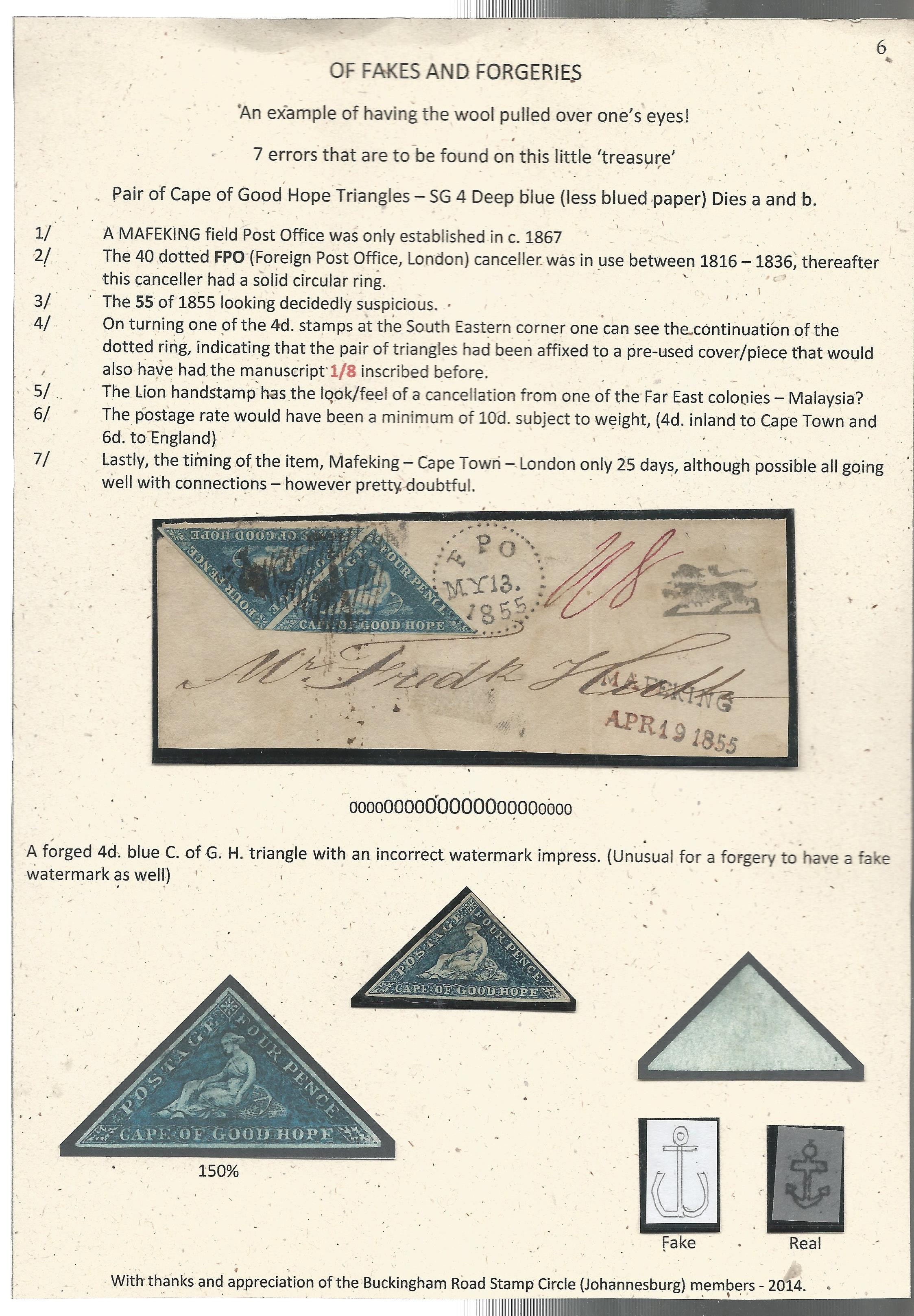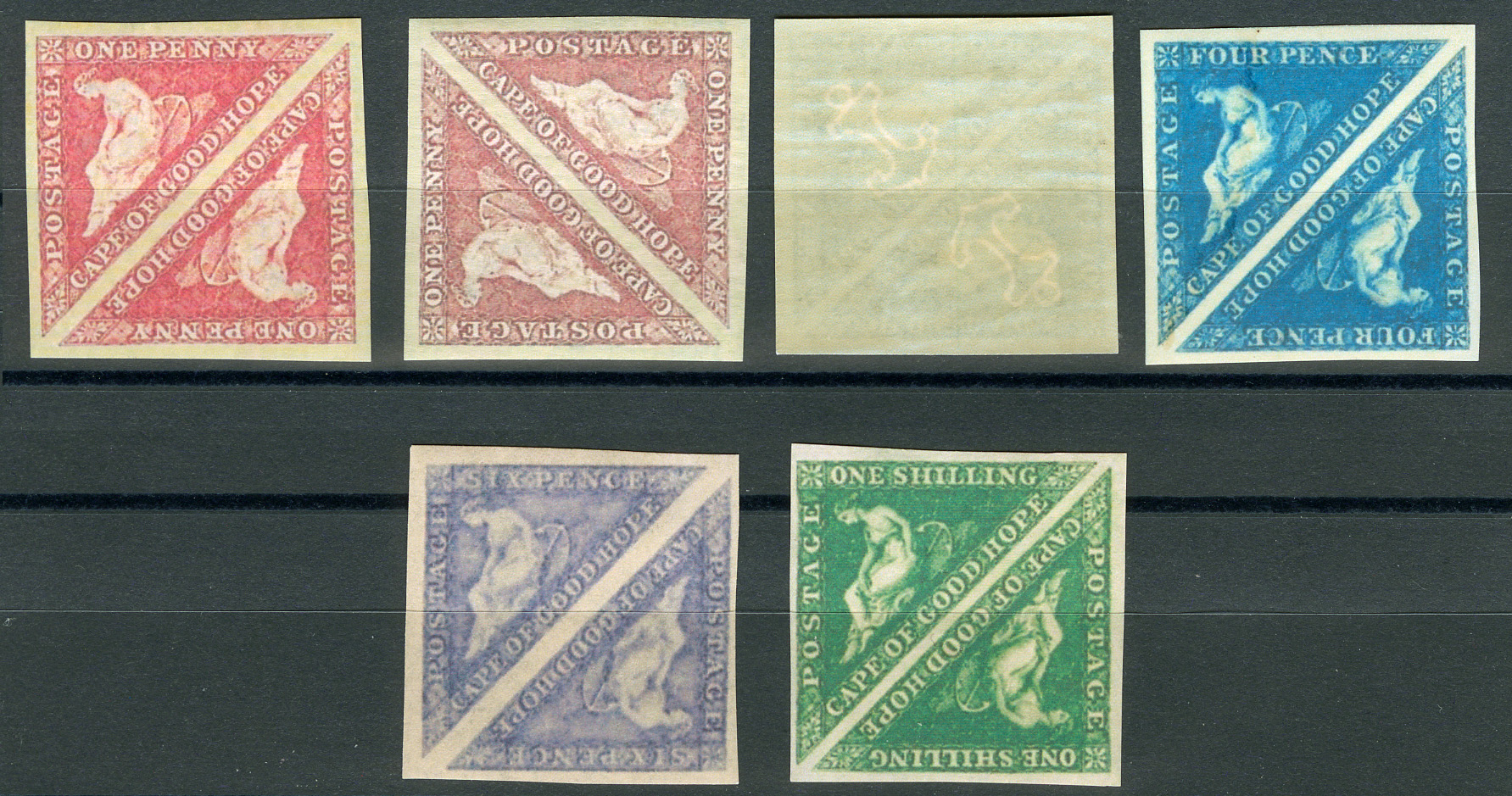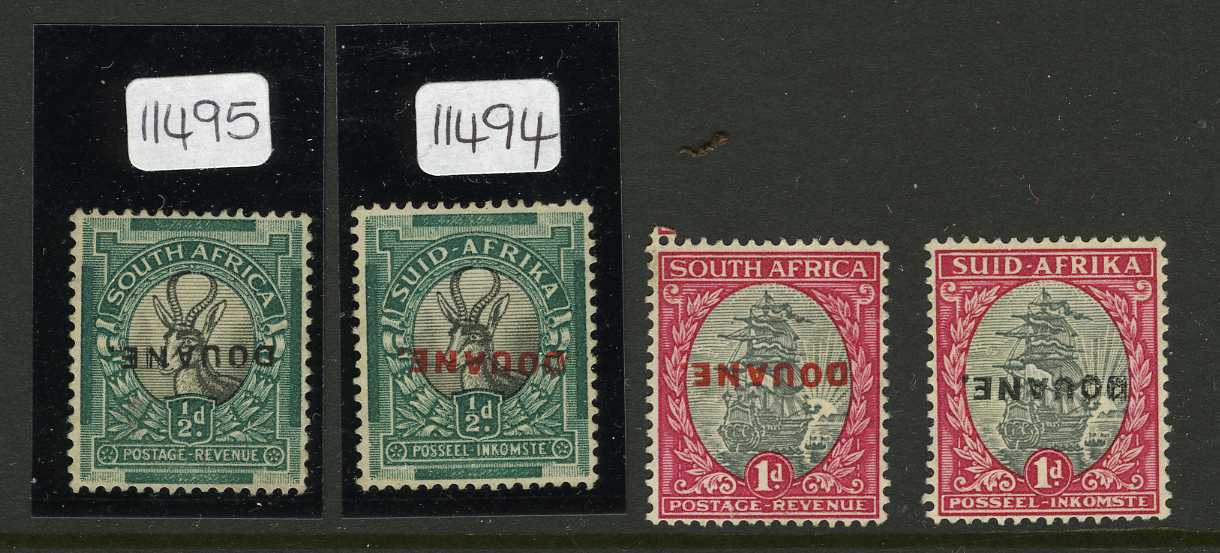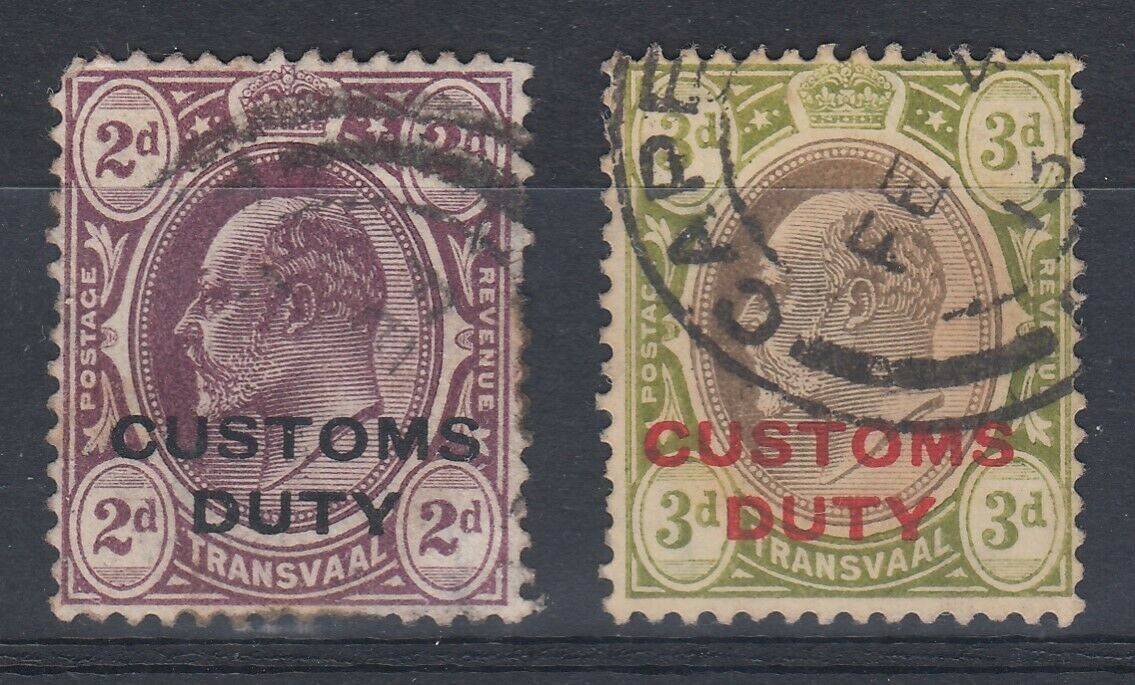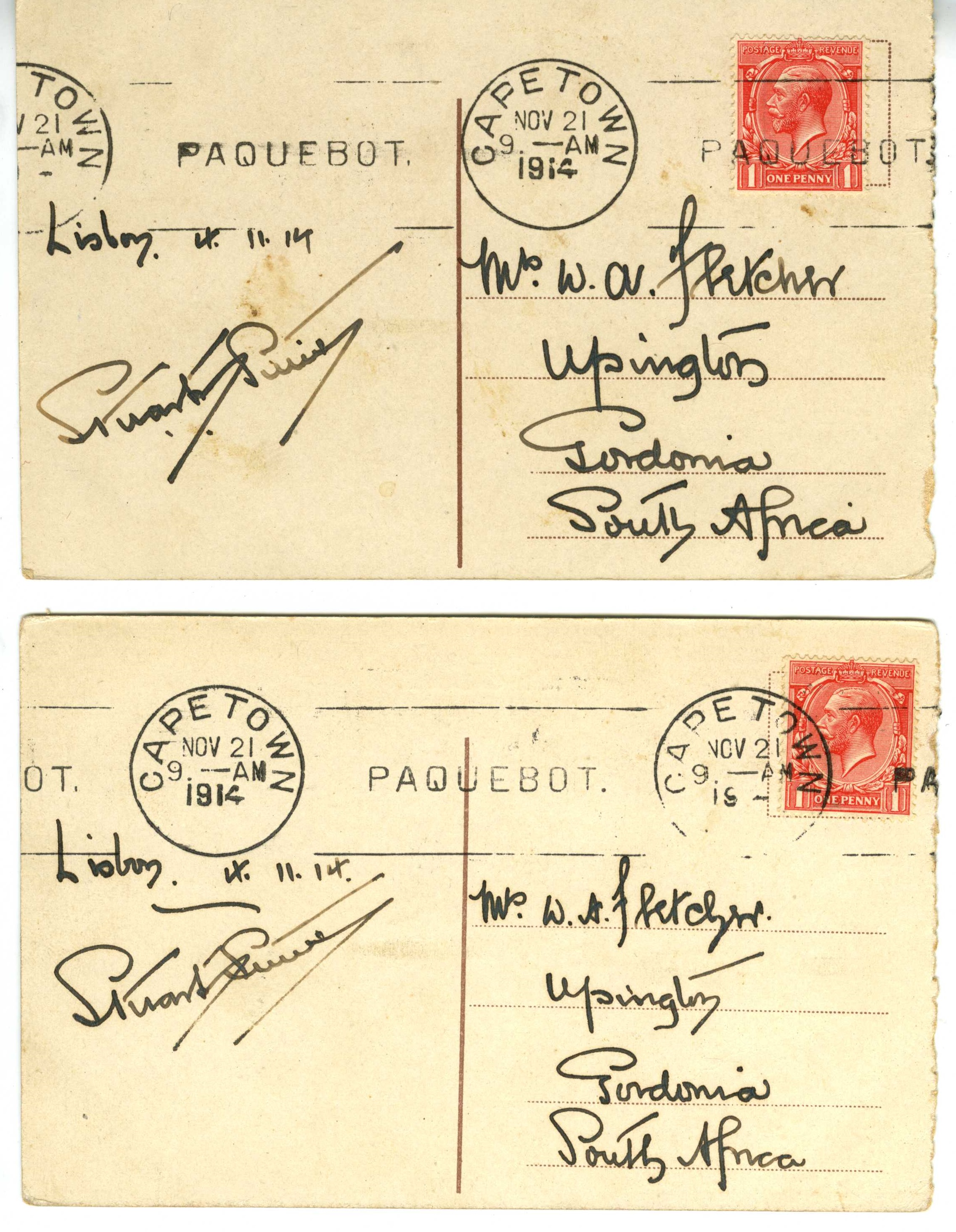Fakes and Forgeries
Quote from Steve on November 29, 2021, 12:03 pmI saw the item below on Kenny Napier's Edenvale November 2021 auction. It was listed as: "LOT 48. Cape of Good Hope 4d blue. 2 interesting forgeries, one with watermark! See scan for details. Estimate R450-R500".
As I collect Fakes and Forgeries of Cape Triangles I put in a bid of R850 that I thought would secure the item. I failed to get it as it sold for a surprising R1200. There are a couple of issues here.
First, the cover is not an item of valuable postal history, nor is the single forged triangle a valuable item of philately. Both are examples of the shady dark art of forgery and fakery. However, I knowingly bid on these items, thereby pushing the price up and sustaining the market for such bogus material, possibly even creating the need for more. This material should not have a place in a legitimate market. But clearly, this material has a value to collectors of Fakes and Forgeries, like me and the buyer. From my side, I buy this material in order to document it so as to be able to advise others of what is genuine and what is not and give them the chance to not be fooled by it.
On the subject of not being fooled, look at the display sheet below containing Lot 48. The writer lists "7 errors that are to be found on this little 'treasure'". The writer does not state that the pair of 4d blue Cape Triangles are forgeries but nor does he say they are genuine. They certainly appear to be very good copies. Unfortunately, with the screen grabbed image I have I cannot zoom in enough to fully see the detail.
It appears that the writer believes the pair of triangles, indeed the original cover without the embellishments, to be genuine. If true, this is a great tribute to the forger's art. From my distant perspective, I very much doubt that they are genuine. Why would you waste a pair of 4d blue Cape triangles on a cack-handed forgery like this? The rest of the cover looks to me like the work of an Italian forger whom some call 'Saul'. (It's all good, man!) I have several similar examples of his work, all with forged Cape triangles capable of fooling a gullible novice or anyone who has not researched the subject enough. Curiously, the writer expresses postal history knowledge that is good in parts but flawed in the most important philatelic part, the classic Cape triangle! Nowhere does he say they are "genuine".
I contacted Kenny Napier about the possibility that the writer thought the pair of triangles to be genuine and he replied "They are without question fakes, not sure what the previous owner thought!" There is no doubt that Kenny's listing was unambiguous - "2 interesting forgeries".
To participate in Kenny's Auctions, email: Kenny Napier <kenny.napier@mweb.co.za>
To the new owner of this item, LOT 49, congratulations! It is great fake, well worth displaying. Hopefully you won't object to me showing it here. If you want to comment on this post and or it, please do so. Thanks.
Anchor Watermark Forgery
Regarding forgeries with watermarks, these are increasingly seen in the modern fakes. Below are five different coloured examples, each with the Anchor watermark and all from the same forger. On zooming in you can see that these are no better than average copies of the Cape Triangle. Few, if any, of the obvious points of genuine reference exist to confuse the knowledgeable. However, the presence of a good approximation of the genuine Anchor watermark, may lead some to think that these are more than the sum of the parts.
I saw the item below on Kenny Napier's Edenvale November 2021 auction. It was listed as: "LOT 48. Cape of Good Hope 4d blue. 2 interesting forgeries, one with watermark! See scan for details. Estimate R450-R500".
As I collect Fakes and Forgeries of Cape Triangles I put in a bid of R850 that I thought would secure the item. I failed to get it as it sold for a surprising R1200. There are a couple of issues here.
First, the cover is not an item of valuable postal history, nor is the single forged triangle a valuable item of philately. Both are examples of the shady dark art of forgery and fakery. However, I knowingly bid on these items, thereby pushing the price up and sustaining the market for such bogus material, possibly even creating the need for more. This material should not have a place in a legitimate market. But clearly, this material has a value to collectors of Fakes and Forgeries, like me and the buyer. From my side, I buy this material in order to document it so as to be able to advise others of what is genuine and what is not and give them the chance to not be fooled by it.
On the subject of not being fooled, look at the display sheet below containing Lot 48. The writer lists "7 errors that are to be found on this little 'treasure'". The writer does not state that the pair of 4d blue Cape Triangles are forgeries but nor does he say they are genuine. They certainly appear to be very good copies. Unfortunately, with the screen grabbed image I have I cannot zoom in enough to fully see the detail.
It appears that the writer believes the pair of triangles, indeed the original cover without the embellishments, to be genuine. If true, this is a great tribute to the forger's art. From my distant perspective, I very much doubt that they are genuine. Why would you waste a pair of 4d blue Cape triangles on a cack-handed forgery like this? The rest of the cover looks to me like the work of an Italian forger whom some call 'Saul'. (It's all good, man!) I have several similar examples of his work, all with forged Cape triangles capable of fooling a gullible novice or anyone who has not researched the subject enough. Curiously, the writer expresses postal history knowledge that is good in parts but flawed in the most important philatelic part, the classic Cape triangle! Nowhere does he say they are "genuine".
I contacted Kenny Napier about the possibility that the writer thought the pair of triangles to be genuine and he replied "They are without question fakes, not sure what the previous owner thought!" There is no doubt that Kenny's listing was unambiguous - "2 interesting forgeries".
To participate in Kenny's Auctions, email: Kenny Napier <kenny.napier@mweb.co.za>
To the new owner of this item, LOT 49, congratulations! It is great fake, well worth displaying. Hopefully you won't object to me showing it here. If you want to comment on this post and or it, please do so. Thanks.
Anchor Watermark Forgery
Regarding forgeries with watermarks, these are increasingly seen in the modern fakes. Below are five different coloured examples, each with the Anchor watermark and all from the same forger. On zooming in you can see that these are no better than average copies of the Cape Triangle. Few, if any, of the obvious points of genuine reference exist to confuse the knowledgeable. However, the presence of a good approximation of the genuine Anchor watermark, may lead some to think that these are more than the sum of the parts.
Uploaded files:Quote from Steve on November 30, 2021, 10:57 amWoke uplast night thinking, I should have added that I think the whole cover is a fake.
From what I've seen of Saul's previous work, assuming this is him, (not positive it is), he fakes everything. Why would you waste a valuable pair of genuine 4d triangles faking a cover? Also, the rate of 1/- and 8d is correct if the letter is over half an ounce and under one. It would be 2 x 4d (Cape rate) plus 2 x 6d (overseas rate) = 1/- 8d.
In other examples of this forger's work, there are similar silly Eurocentric embellishments (FPO) which should as a red flag to any reasonably knowledgeable viewer. But if you are buying fakes for fakes sake, then this is a nice item to acquire and therein lies the rub. You are going to want to acquire it because it is such a preposterous imposter!
Woke uplast night thinking, I should have added that I think the whole cover is a fake.
From what I've seen of Saul's previous work, assuming this is him, (not positive it is), he fakes everything. Why would you waste a valuable pair of genuine 4d triangles faking a cover? Also, the rate of 1/- and 8d is correct if the letter is over half an ounce and under one. It would be 2 x 4d (Cape rate) plus 2 x 6d (overseas rate) = 1/- 8d.
In other examples of this forger's work, there are similar silly Eurocentric embellishments (FPO) which should as a red flag to any reasonably knowledgeable viewer. But if you are buying fakes for fakes sake, then this is a nice item to acquire and therein lies the rub. You are going to want to acquire it because it is such a preposterous imposter!
Quote from Bas PAYNE on November 30, 2021, 11:38 amFascinating - many thanks for sharing ...
It's sometimes hard to understand the motivations behind forgery. Often, yes, it's simple fraud to get money; but that doesn't seem to be true always. Here are a couple of examples.
The first is a group of DOUANE overprints. The font is reasonably good, even if the printing is a bit faint; if done upright and in black, I don't think many people would spot them as fakes. But inverted - and in red? But why do it? I don't think anyone would have hoped to get rich selling them .... I bought the group for £5.
The second is a Cape Town machine cancellation with the slogan "POSTAGE FREE PASSED BY CENSOR". There seems to be some uncertainty about how many other examples exist - there's one reported on a cover from Luderitzbucht, and possibly one or two others (I'd welcome any information), all with the same date and time of day. However the use of this slogan in a machine canceller seems inherently improbable. The point about censorship is that a censor looks at each item individually - it's not something that can or should be done mechanically in large batches.
Any comments welcomed ...
Fascinating - many thanks for sharing ...
It's sometimes hard to understand the motivations behind forgery. Often, yes, it's simple fraud to get money; but that doesn't seem to be true always. Here are a couple of examples.
The first is a group of DOUANE overprints. The font is reasonably good, even if the printing is a bit faint; if done upright and in black, I don't think many people would spot them as fakes. But inverted - and in red? But why do it? I don't think anyone would have hoped to get rich selling them .... I bought the group for £5.
The second is a Cape Town machine cancellation with the slogan "POSTAGE FREE PASSED BY CENSOR". There seems to be some uncertainty about how many other examples exist - there's one reported on a cover from Luderitzbucht, and possibly one or two others (I'd welcome any information), all with the same date and time of day. However the use of this slogan in a machine canceller seems inherently improbable. The point about censorship is that a censor looks at each item individually - it's not something that can or should be done mechanically in large batches.
Any comments welcomed ...
Uploaded files:
Quote from Steve on November 30, 2021, 2:34 pmThanks, Bas.
I am glad to see I am not the only one sustaining the fake and forgery market.
As you said "fascinating".... and that I think is half the attraction of fakes and forgeries .... they're fascinating in a way that genuine stamps and postmarks are not. It requires a test of your knowledge to spot them. Therein lies much of the fascinating fun. Its a way of discovering and showing others how much you've learned, not in a show-off sort of way, but more as someone approaching the top of his game.
Admission. I believe I have a red 'DOUANE' (Afr. Customs) somewhere. I never knew enough to take it for a fake. I am wiser now. I haven't a clue where it is but if I find it one day I will add it to this thread.
PASSED BY CENSOR. Now this is a lovely fake. I am utterly envious. I will have to take your word for it that it is a fake - I know you have studied machine cancellers - but I have NEVER seen another machine canceller like this which is, as you point out, a clue to the genuineness of this item. You would have thought if censored mail was machine cancelled there would be more of it about. Your explanation about censorship being done individually is exactly how I imagine it was done. I can only imagine that the person who created this had a sense of humuor bigger than their need to make some money. They were having a laugh!
Thanks, Bas.
I am glad to see I am not the only one sustaining the fake and forgery market.
As you said "fascinating".... and that I think is half the attraction of fakes and forgeries .... they're fascinating in a way that genuine stamps and postmarks are not. It requires a test of your knowledge to spot them. Therein lies much of the fascinating fun. Its a way of discovering and showing others how much you've learned, not in a show-off sort of way, but more as someone approaching the top of his game.
Admission. I believe I have a red 'DOUANE' (Afr. Customs) somewhere. I never knew enough to take it for a fake. I am wiser now. I haven't a clue where it is but if I find it one day I will add it to this thread.
PASSED BY CENSOR. Now this is a lovely fake. I am utterly envious. I will have to take your word for it that it is a fake - I know you have studied machine cancellers - but I have NEVER seen another machine canceller like this which is, as you point out, a clue to the genuineness of this item. You would have thought if censored mail was machine cancelled there would be more of it about. Your explanation about censorship being done individually is exactly how I imagine it was done. I can only imagine that the person who created this had a sense of humuor bigger than their need to make some money. They were having a laugh!
Quote from Bas PAYNE on November 30, 2021, 4:50 pmSteve:
Red CUSTOMS DUTY overprints are fine - in the early period, red was used on some values because black wouldn't have stood out. I'll attach an example.
Whether a stamp or a cover is a fake or not is all too often a matter of opinion, and this applies very much to the POSTAGE FREE PASSED BY CENSOR slogan cancel. I can't show that it's a fake by any objective test - it just seems very unlikely, and the fact that all the known examples have the same time and date adds more doubt.
Where objective tests exist, experts and expert committees are often very unwilling to tell people about them - the fear is that this will help fakers to produce fakes that pass the test ....
Steve:
Red CUSTOMS DUTY overprints are fine - in the early period, red was used on some values because black wouldn't have stood out. I'll attach an example.
Whether a stamp or a cover is a fake or not is all too often a matter of opinion, and this applies very much to the POSTAGE FREE PASSED BY CENSOR slogan cancel. I can't show that it's a fake by any objective test - it just seems very unlikely, and the fact that all the known examples have the same time and date adds more doubt.
Where objective tests exist, experts and expert committees are often very unwilling to tell people about them - the fear is that this will help fakers to produce fakes that pass the test ....
Uploaded files:
Quote from Steve on December 1, 2021, 10:27 amThanks! I am doubly wiser and humbled now!
Your PASSED BY CENSOR machine canceller is pretty perfect. Assuming it is a fake, was it actually made on a machine canceller or is it contrived to merely look like its been through an MC? If you were a faker using a genuine MC with fabricated PBC slogan, you would want to run a bunch of covers through all at once, hence the same time and date. But if it was genuine use you would do the same. I think the clue to it being genuine or not must lie in a comparison of all the other known covers. Are they all the same as yours ie. perfect or do they display slight differences like being slightly skewed and erratic placed on the cover as you get in genuine MC usage?
I think we have to thank the fakers and forgers for this thread!
Thanks! I am doubly wiser and humbled now!
Your PASSED BY CENSOR machine canceller is pretty perfect. Assuming it is a fake, was it actually made on a machine canceller or is it contrived to merely look like its been through an MC? If you were a faker using a genuine MC with fabricated PBC slogan, you would want to run a bunch of covers through all at once, hence the same time and date. But if it was genuine use you would do the same. I think the clue to it being genuine or not must lie in a comparison of all the other known covers. Are they all the same as yours ie. perfect or do they display slight differences like being slightly skewed and erratic placed on the cover as you get in genuine MC usage?
I think we have to thank the fakers and forgers for this thread!
Quote from Bas PAYNE on December 1, 2021, 11:00 amYes - that would be the sensible thing to do, and also to compare the lengths of the strikes - as the card or letter is propelled by rotation of the cylinder, there is often slippage, and also whether there are marks above and below the slogan produced by the slightly raised cross-hatched areas at the top and bottom of the cylinder - sometimes these leave ink traces, sometimes just indentations on the paper. It's suspicious that there's no trace of these in the scan.
But to do either, one would either need the specimens in hand, or high-resolution scans, which I don't have.
Yes - that would be the sensible thing to do, and also to compare the lengths of the strikes - as the card or letter is propelled by rotation of the cylinder, there is often slippage, and also whether there are marks above and below the slogan produced by the slightly raised cross-hatched areas at the top and bottom of the cylinder - sometimes these leave ink traces, sometimes just indentations on the paper. It's suspicious that there's no trace of these in the scan.
But to do either, one would either need the specimens in hand, or high-resolution scans, which I don't have.
Quote from Steve on December 1, 2021, 2:23 pmHopefully somebody reading this who has such a copy - what are the chances of that? - can post it here. It would be good to see at least just one more. If it is a fake, I am sure it will be in pretty fine condition, like yours.
Hopefully somebody reading this who has such a copy - what are the chances of that? - can post it here. It would be good to see at least just one more. If it is a fake, I am sure it will be in pretty fine condition, like yours.
Quote from Bas PAYNE on December 2, 2021, 12:56 pmA postscript: by coincidence, these postcards arrived today. Both were posted at the same time (9 AM, NOV 21 1914) at Cape Town, with PAQUEBOT machine cancellations - and they show the kinds of individual minor variations - weak areas, smudges etc. - that you'd expect in genuine examples. There are no visible pressure marks from the raised edges of the cylinder - the card may be too hard for these to show.
They are the earliest examples I've seen of this cancellation (Vermaak gives 1915 as the earliest date that he had seen); if anyone has seen an earlier on, please tell me ....
A postscript: by coincidence, these postcards arrived today. Both were posted at the same time (9 AM, NOV 21 1914) at Cape Town, with PAQUEBOT machine cancellations - and they show the kinds of individual minor variations - weak areas, smudges etc. - that you'd expect in genuine examples. There are no visible pressure marks from the raised edges of the cylinder - the card may be too hard for these to show.
They are the earliest examples I've seen of this cancellation (Vermaak gives 1915 as the earliest date that he had seen); if anyone has seen an earlier on, please tell me ....
Uploaded files:Quote from Steve on December 3, 2021, 11:16 amA digression: by coincidence I am finishing off Part 2 of my Namibia display, 'WW1 and Occupation by South Africa'. Cape Town was the main port for the embarkation of troops and supplies for the GSWA campaign. The invasion of German South West Africa began in September 1914. This led to rebellion in South Africa in October by unreconciled Republicans and the temporary disruption of the invasion plans.
I am wondering if your two lovely Paquebot machine cancellers had anything to do with troop transport to GSWA. They are slap-bang in the middle of this invasion/rebellion period. I am guessing not. General Botha spent most of November gathering his UDF forces in South Africa and crushing the rebellion. Only once that was accomplished did he return to invading GSWA in late December 1914.
I am intrigued as to what is written alongside the date of 4. 11. 14. Is it 'Lisbon?'. If 'yes', then I have my answer - "No, nothing to do with troop movements to GSWA'.
As an aside to my digression, when these postcards were machine cancelled in Cape Town, the Prince Alfred's Guard, a loyal Eastern Cape Regiment, was mutinying against the boredom of harbour defence duties in Cape Town. For this failure of imperial enthusiasm to serve in GSWA, it would be banned from all involvement in the conflict. Finally, the addressee in 'Gordonia', (wonderful), would presumably soon be an unwilling participant in the 'Battle of of Upington', an obscure engagement fought in the northern Cape.
At dawn on 24th January 1915, the rebel leaders Maritz and Kemp had 1,200 men make a frontal assault across open ground against Colonel Jaap van Deventer’s 2,000 man UDF (Union Defence Force) garrison in Upington, some 250 km from GSWA. Van Deventer’s force was part of the larger ‘B Force’ intended to form one of the UDF’s four columns for the planned invasion of GSWA. Fighting was severe, rebel losses were unacceptably heavy and the attack failed. Kemp was suffering from Blackwater Fever and was depressed by this and other rebel military failures. Realising that the Republican Rebellion was over, he chose to surrender with his rebels at Upington on 30th January. As Van Deventer and Maritz had been comrades in the northern Cape during the South African War where they fought under General Smuts, Maritz helped arrange Kemp’s surrender before slipping across the border into GSWA. Maritz would flee to Angola at the end of Botha’s successful GSWA campaign. He would be sentenced to a mere 3 years imprisonment for his bloody treachery. The incoming government of J B M Hertzog, another SAW general and proponent of Boer cronyism, (corruption by another name), would pardon Maritz after just 6 months in jail.
Most probably, these two postcards lay in a drawer in Upington during the morning's brief battle. As such they were there as much as any person to experience the boom of artillery, the concussion of exploding shells, the crackle of rifle fire, the rattle of raking machine-guns, the cries of men and horses, perhaps even catch a whiff of burning veld and buildings, blood, sweat and cordite. For me, this is a vivid reminder of that time during the divisive early days of the First World War when White South Africans took sides to fight each other as the proxies of two European empires, neither of whom cared a hoot about us, nor the immediate and or long-term politcal rights of the majority Black South African population. Indeed, it seems to me that whichever side we fought on, it was the losing side.
Our political life in White South Africa was the product of self-interested Fakery and Forgery.
A digression: by coincidence I am finishing off Part 2 of my Namibia display, 'WW1 and Occupation by South Africa'. Cape Town was the main port for the embarkation of troops and supplies for the GSWA campaign. The invasion of German South West Africa began in September 1914. This led to rebellion in South Africa in October by unreconciled Republicans and the temporary disruption of the invasion plans.
I am wondering if your two lovely Paquebot machine cancellers had anything to do with troop transport to GSWA. They are slap-bang in the middle of this invasion/rebellion period. I am guessing not. General Botha spent most of November gathering his UDF forces in South Africa and crushing the rebellion. Only once that was accomplished did he return to invading GSWA in late December 1914.
I am intrigued as to what is written alongside the date of 4. 11. 14. Is it 'Lisbon?'. If 'yes', then I have my answer - "No, nothing to do with troop movements to GSWA'.
As an aside to my digression, when these postcards were machine cancelled in Cape Town, the Prince Alfred's Guard, a loyal Eastern Cape Regiment, was mutinying against the boredom of harbour defence duties in Cape Town. For this failure of imperial enthusiasm to serve in GSWA, it would be banned from all involvement in the conflict. Finally, the addressee in 'Gordonia', (wonderful), would presumably soon be an unwilling participant in the 'Battle of of Upington', an obscure engagement fought in the northern Cape.
At dawn on 24th January 1915, the rebel leaders Maritz and Kemp had 1,200 men make a frontal assault across open ground against Colonel Jaap van Deventer’s 2,000 man UDF (Union Defence Force) garrison in Upington, some 250 km from GSWA. Van Deventer’s force was part of the larger ‘B Force’ intended to form one of the UDF’s four columns for the planned invasion of GSWA. Fighting was severe, rebel losses were unacceptably heavy and the attack failed. Kemp was suffering from Blackwater Fever and was depressed by this and other rebel military failures. Realising that the Republican Rebellion was over, he chose to surrender with his rebels at Upington on 30th January. As Van Deventer and Maritz had been comrades in the northern Cape during the South African War where they fought under General Smuts, Maritz helped arrange Kemp’s surrender before slipping across the border into GSWA. Maritz would flee to Angola at the end of Botha’s successful GSWA campaign. He would be sentenced to a mere 3 years imprisonment for his bloody treachery. The incoming government of J B M Hertzog, another SAW general and proponent of Boer cronyism, (corruption by another name), would pardon Maritz after just 6 months in jail.
Most probably, these two postcards lay in a drawer in Upington during the morning's brief battle. As such they were there as much as any person to experience the boom of artillery, the concussion of exploding shells, the crackle of rifle fire, the rattle of raking machine-guns, the cries of men and horses, perhaps even catch a whiff of burning veld and buildings, blood, sweat and cordite. For me, this is a vivid reminder of that time during the divisive early days of the First World War when White South Africans took sides to fight each other as the proxies of two European empires, neither of whom cared a hoot about us, nor the immediate and or long-term politcal rights of the majority Black South African population. Indeed, it seems to me that whichever side we fought on, it was the losing side.
Our political life in White South Africa was the product of self-interested Fakery and Forgery.

